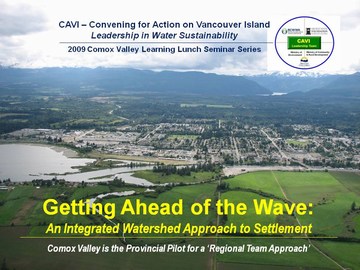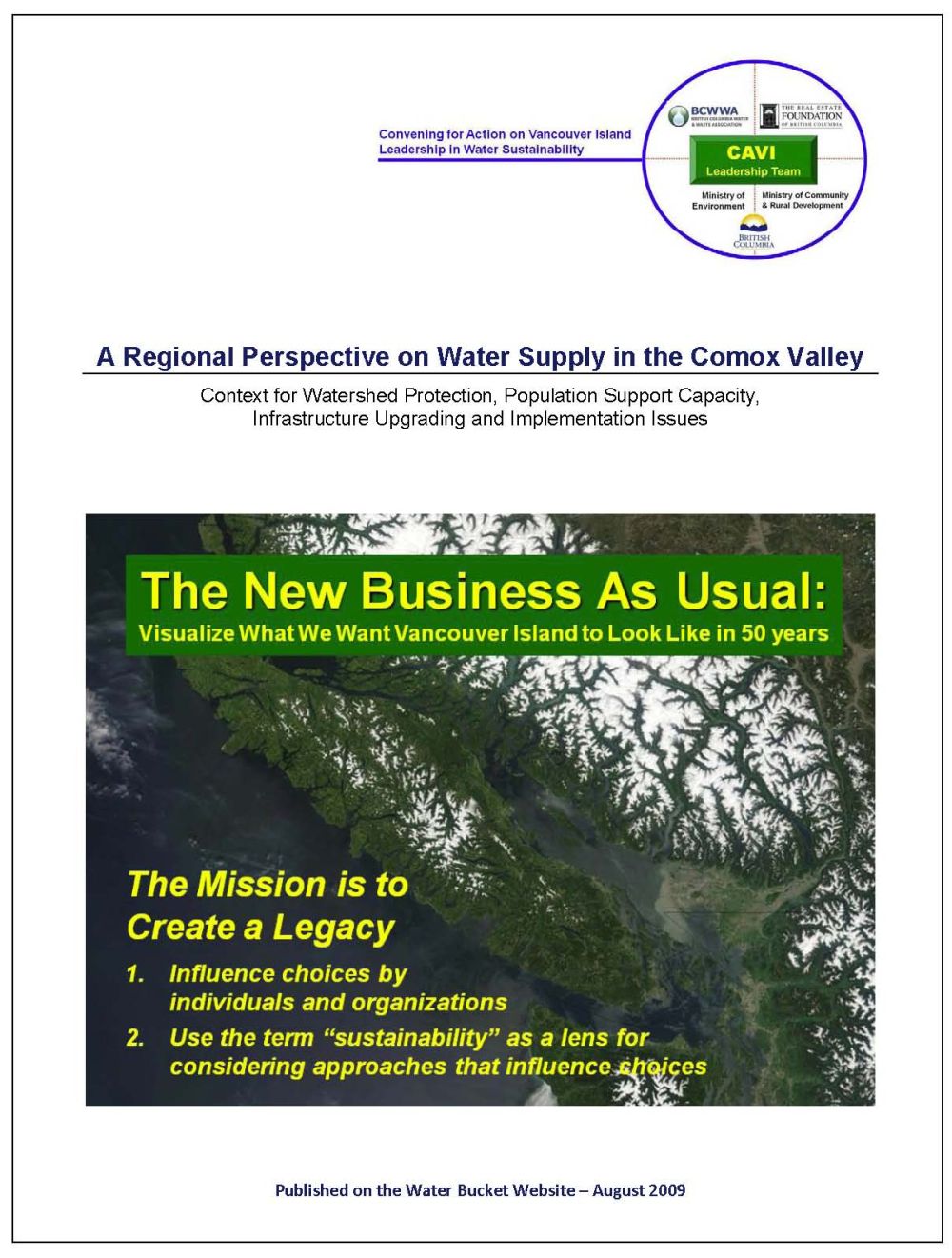Living Water Smart commitments frame learning outcomes for Comox Valley Learning Lunch Program – “Fifty percent of new municipal water needs will be acquired through conservation by 2020” (p 75 Living Water Smart)

Closing the Loop
 “Circumstances have provided the Comox Valley with the opportunity to embrace a ‘closed loop’ approach to water resource management. In short, this means water is water. Drinking water, waste water and drainage water are uses at different points within a cycle,” states Eric Bonham. He is a founding member of the Convening for Action on Vancouver Island Leadership Team, and formerly a Director in the Ministry of Municipal Affairs.
“Circumstances have provided the Comox Valley with the opportunity to embrace a ‘closed loop’ approach to water resource management. In short, this means water is water. Drinking water, waste water and drainage water are uses at different points within a cycle,” states Eric Bonham. He is a founding member of the Convening for Action on Vancouver Island Leadership Team, and formerly a Director in the Ministry of Municipal Affairs.
“Low flow conditions in the Comox Lake system have provided a reality-check in terms  of how water is managed. The drinking water allocation is fully utilized by the existing population, and is in fact being exceeded on occasion. This is a catalyst for doing business differently going forward,” states Marc Rutten, Senior Manager of Engineering Services with the Comox Valley Regional District (CVRD).
of how water is managed. The drinking water allocation is fully utilized by the existing population, and is in fact being exceeded on occasion. This is a catalyst for doing business differently going forward,” states Marc Rutten, Senior Manager of Engineering Services with the Comox Valley Regional District (CVRD).
“Another catalyst is the Province’s expectation that there will be alignment of actions at three scales – provincial, regional and local – to live water smart and build greener communities,” adds Michael Zbarsky, Engineering Analyst with the CVRD.
The New Business As Usual
“Living Water Smart and the Green Communities Initiative provide British Columbians  with a vision of what the regions of our province can look like if local governments prepare communities for change, choose to be water smart, and strive to achieve settlement in balance with ecology – in other words, implement The New Business As Usual,” states Kim Stephens, Program Coordinator for the Water Sustainability Action Plan for British Columbia, and moderator for the 2009 Comox Valley Learning Lunch Series.
with a vision of what the regions of our province can look like if local governments prepare communities for change, choose to be water smart, and strive to achieve settlement in balance with ecology – in other words, implement The New Business As Usual,” states Kim Stephens, Program Coordinator for the Water Sustainability Action Plan for British Columbia, and moderator for the 2009 Comox Valley Learning Lunch Series.
Learning Lunch Program
Living Water Smart comprises 45 commitments. According to Kim Stephens, two of these commitments frame the learning outcomes for the Comox Valley Learning Lunch Program:
- 2008 Series: “By 2012, all land and water managers will know what makes a stream healthy, and therefore be able to help land and water users factor in new approaches to securing stream health and the full range of stream benefits.” (p 43 Living Water Smart)
- 2009 Series: “Fifty percent of new municipal water needs will be acquired through conservation by 2020.” (p 75 Living Water Smart)
“These are complementary outcomes. The link is water-centric land development standards,” concludes Kim Stephens.
Understanding the Context
To learn about the regional water context for Living Water Smart in the Comox Valley, click on A Regional Perspective on Water Supply in the Comox Valley.


